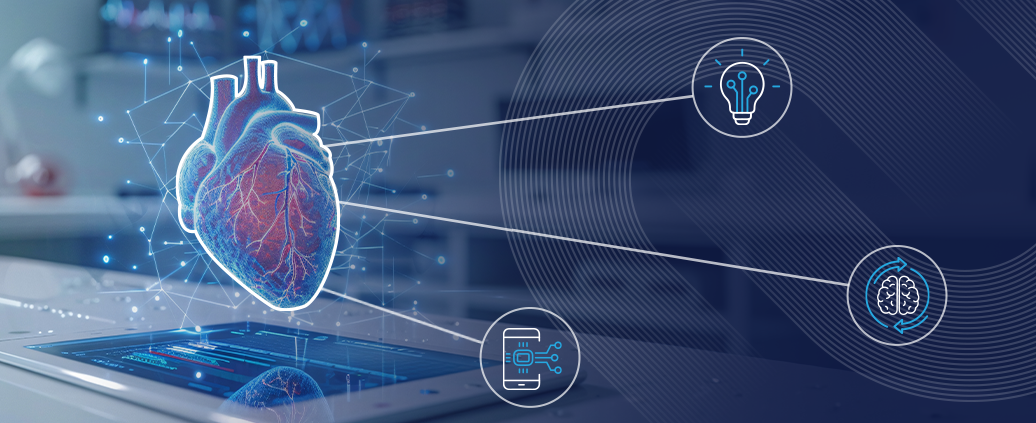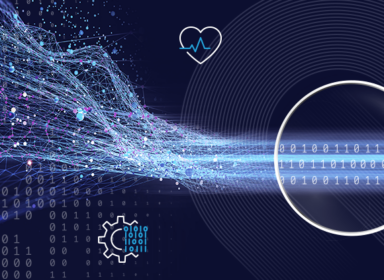Imagine a world where the subtle signs of heart disease are detected before symptoms appear, where continuous monitoring is the norm, and where personalized treatment plans are crafted with unparalleled precision. This is the world that InfoBionic.Ai is not just envisioning, but is committed to actively creating.
With the integration of artificial intelligence (AI) in healthcare, this vision is no longer a distant future but a transformational reality that already exists. Nowhere is this more evident than in virtual cardiac telemetry, where AI’s ability to analyze and make actionable vast amounts of data in near real-time is revolutionizing patient care.
InfoBionic.Ai remains at the forefront of AI’s revolutionary application in healthcare, pioneering cutting-edge remote cardiac monitoring devices empowered by AI-enabled analytics that enhance how cardiac conditions are diagnosed, treated, and managed. Over the past year, we have authored many thought leadership articles for healthcare publications that provide tangible insights into how AI is transforming cardiac care. These articles not only highlight the lifesaving potential of the technology, from early detection of atrial fibrillation (AFib) to continuous remote monitoring for high acuity patients, but also demonstrate our expertise and commitment to continually advancing virtual cardiac telemetry through the application of AI.
Racing to the Zero Milestone: Accelerating Progress in Cardiac Care with AI-Enabled Analysis
Cardiac disease is the leading cause of death in the United States, making it a critical public health concern. The healthcare ecosystem is becoming dedicated to improving heart health to achieve the ‘zero’ milestone—a hypothetical state with zero avoidable cardiac deaths. This article explores how we can turn this vision into reality through AI-enabled virtual cardiac telemetry.
Accurate diagnosis of cardiac conditions can significantly improve outcomes and put us on the path to the zero milestone. AI makes this possible by analyzing ECG data in near real-time, detecting abnormalities missed by the human eye. Integrating AI into cardiac telemetry enables continuous monitoring and early intervention, leading to faster, more precise diagnoses and personalized treatment plans.
Top 3 Things You’ll Learn from this Article:
- How healthcare organizations can revitalize ‘medical deserts’ and amplify proactivity in cardiac intervention through AI-enabled analysis and virtual telemetry.
- Ways to address virtual cardiac telemetry’s key challenges, which include data overload, poor technology integration, provider constraints, and more.
- How AI-enabled analysis creates a seismic shift in overcoming limitations of remote patient monitoring (RPM) and turning obstacles into opportunities for improved care.
Read on to learn how AI is revolutionizing diagnostics and treatment in cardiology as we race to the ‘zero’ milestone.
Putting the ‘Continuous’ in the Cardiac Care Continuum
In cardiac diagnostics, combining wearable technology with continuous data transmission is revolutionary. When paired with AI-enabled analytics, near real-time continuous monitoring ensures no heartbeat goes undetected, providing seamless cardiac care regardless of patient location or level of acuity.
As continuous monitoring generates vast amounts of data, AI-powered analysis serves a critical role in identifying key insights, reducing clinical burden, and minimizing errors. Constant vigilance allows for the immediate detection of anomalies, enabling rapid intervention at scale. This article explores how integrating wearable tech, continuous data, and AI-powered analysis enhances patient safety and quality of life, reduces hospital visits, and enables more proactive cardiac condition management across the entire cardiac care continuum.
Top 3 Things You’ll Learn from this Article:
- How wearable tech, continuous data, and AI-enabled analysis work together to drive better outcomes in cardiac care.
- Tangible examples of how AI-enabled analysis detects patterns and subtleties that were previously undetected to the clinical eye.
- How continuous monitoring and AI-enabled analysis are transforming the entire continuum of cardiac care, from standard primary care to diagnosis, disease management, and beyond.
Read more about how AI-powered technology is setting new standards in continuous cardiac care.
Reading the Signs: How Wearables, Continuous Monitoring, and AI Are Shining New Light on Cardiac Risk
Wearable cardiac technology and AI-enabled analytics are transforming cardiac risk management. With sophisticated algorithms that analyze data in near real-time to detect anomalies and predict potential cardiac events, AI is more than just an innovative technology—it is the North Star that has ushered in a new era of proactive cardiac care.
With cardiovascular diseases securely maintaining their position as a leading cause of death globally, early detection could be not just life-changing, but lifesaving. In fact, AI-driven wearables can provide a crucial early warning system, allowing patients to seek medical attention before a crisis occurs. This empowers patients to become stakeholders in their heart health, leading to better outcomes. In this article, we describe how taking a more proactive and prescriptive approach to cardiac care with AI-powered wearables and continuous monitoring drastically reduces cardiac risk.
Top 3 Things You’ll Learn:
- The leading factors and symptoms that result in a cardiac diagnosis.
- How strides in wearable technology, continuous monitoring, and AI-enabled analysis have addressed the issues that prevent robust cardiac diagnostics from reaching more patients.
- A case study that shows how technology is shining a light on the earliest, most nuanced indicators of cardiac disease.
Read on to learn how wearables, continuous monitoring, and AI are revolutionizing cardiac risk management and unveiling better preventative care.
The Unsung Hero: Unpacking the Critical Role of High-Integrity Data in Virtual Cardiac Telemetry
Healthcare has made many technological advancements over the last decade. As innovation continues to move forward at an unprecedented rate, it’s natural to focus on the next big breakthrough. But when we examine these diverse breakthroughs, we uncover an unsung hero that supports and impacts nearly every area of healthcare innovation: high-integrity data.
Similarly, data is the backbone of more effective virtual cardiac telemetry, but it must be efficiently gathered and skillfully analyzed to be impactful. Rigorous validation and quality control are essential to ensure data integrity, directly impacting the performance of AI algorithms. High-integrity data provides a solid foundation for clinical decision-making, leading to better-targeted and more effective treatments. This article delves specifically into the critical role that high-integrity data plays in enhancing diagnostic precision in cardiology.
Top 3 Things You’ll Learn:
- Why data integrity is so critical for the future of cardiac care.
- How non-event data’s robust insights lead to more effective personalized care.
- Key characteristics to consider in a virtual telemetry solution that delivers data integrity in support of AI-powered interventions.
Read the article to discover how high-integrity data serves as the unsung hero in AI-enabled virtual cardiac telemetry.
Cardiology’s Quantum Leap: How AI-Empowered Hospital-Grade Remote Monitoring Bridges the Great Divide Between Clinical Needs and Clinician Shortages
Today, there’s a greater demand for cardiac services than ever before, yet a waning supply of clinicians available to fulfill these needs. This growing divide must be addressed, and healthcare urgently requires a better way to enhance diagnostic efficiency at scale. AI-enabled hospital-grade remote patient monitoring is uniquely positioned to bridge the cardiology supply and demand gap by more effectively meeting patient needs while reducing care team burden.
Continuous data collection by remote monitoring devices supplemented with AI-powered analysis provides clinicians with more detailed and actionable insights into a patient’s cardiac condition. This article explores how AI-enabled remote cardiac monitoring provides a comprehensive, near real-time view of a patient’s heart, allowing for timely interventions and personalized treatment plans—bridging the pervasive gap through more efficient cardiac care.
Top 3 Things You’ll Learn:
- Why hospital-grade monitoring is the gold standard for more efficient cardiac care.
- How AI-enabled virtual cardiac telemetry meets growing patient needs as it simultaneously alleviates mounting clinician shortages.
- Key strategies to make high-quality cardiac monitoring more accessible to patients, breaking down barriers to healthcare.
Read more to learn how AI-enabled remote cardiac monitoring is closing the great divide.
The ABCs of Cardiac Care: Detailing the Immense Impact of Acuity in Data, Better Patient Experience, and Computational Power
AI is transforming cardiac care at every level. A new suite of seminal advancements powered by AI has arrived, fundamentally elevating the efficiency and effectiveness of cardiac workflows, diagnostics, and interventions. These advancements build upon the legacy of 24-hour monitoring while empowering data fidelity, improving the patient experience, and amplifying insight.
This article explores three seminal advancements: the ‘ABC’s’ of cardiac care. They include acuity in data, better patient experience, and computational power, together combined to enable new possibilities in cardiac diagnostics and disease management. Supported by the three ABC’s, providers are able to assess the acuity of cardiac conditions more effectively, identify patients at risk of cardiac events, facilitate early interventions, and ultimately improve patient satisfaction.
Top 3 Things You’ll Learn:
- How acuity in data enables hospital-grade monitoring from nearly anywhere.
- Ways in which a better patient experience lowers barriers to adoption and adherence.
- How computational power transforms high-volume data into tangible insight with AI.
Read on to learn more about the ABCs of cardiac care and their powerful application in virtual cardiac telemetry.
What You Don’t Know Can Kill You: Unmasking AFib’s Sneaky Onset Through AI-Enabled Virtual Telemetry
AFib, a common yet often undiagnosed cardiac condition, is a silent killer that often evades detection until it’s too late. Affecting over 6 million Americans and responsible for nearly 160,000 deaths each year, AFib’s prevalence is a growing concern for citizens and healthcare providers alike.
This article reveals how AI-enabled virtual cardiac telemetry can be used to detect AFib in its earliest stages, providing a lifeline to patients who might otherwise be unaware of their condition. It highlights how AI-enabled virtual cardiac telemetry is uniquely able to detect AFib’s subtle signs, which traditional methods often miss. By continuously monitoring and analyzing cardiac data, AI enables early and accurate AFib detection with remarkable precision, significantly reducing time to diagnosis and enabling interventions that prevent complications.
Top 3 Things You’ll Learn:
- How the precision of AI-enabled analysis in virtual cardiac telemetry plays a pivotal role in the early detection of AFib, before symptoms become apparent.
- How virtual telemetry and AI-powered technology work together to help lower AFib-related complications and improve cardiac care for patients at any level of acuity.
- Four key criteria to consider when choosing the right virtual telemetry solution to monitor for AFib.
Read the article to discover how virtual cardiac monitoring and AI-enabled analysis work hand in hand in mitigating AFib across the population.
Remain at the Forefront of AI in Cardiology with InfoBionic.Ai
The gold standard for quality and innovation in virtual cardiac telemetry, InfoBionic.Ai continues to blaze a new trail in the application of AI to cardiology. InfoBionic.Ai’s solutions serve as a tangible example of the transformative impact of AI and remote monitoring in the cardiology service line.
By combining AI with flexible monitoring solutions that can replicate clinical-grade telemetry from anywhere, InfoBionic.Ai’s MoMe ARC® can detect subtle signs of heart disease that exist beyond the sight of traditional monitoring systems, enabling more timely interventions that can save lives.
Join us as we step into the future of AI-enabled cardiac care—contact us today to learn more about the MoMe ARC®.


